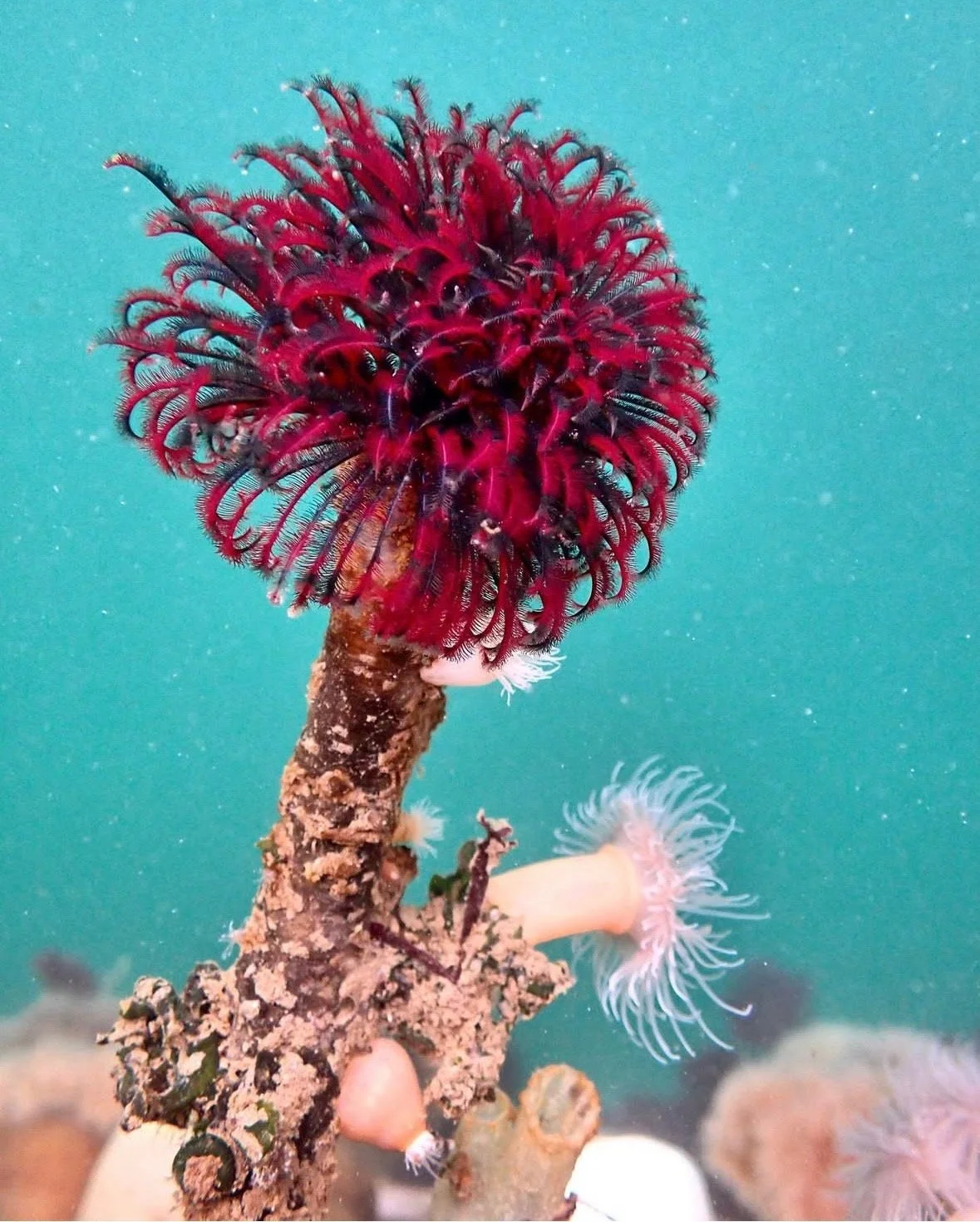Segmented Worms (Order: Phyllodocida)
Leafy shimmyworm (photo credit: Apollo Ross)
Possibly a pile worm hanging from a mussel bed (photo credit: Angela Whitlock)
Frilled commensal scaleworm on an ochre sea star (photo credit: Dani Nielsen)
Northern feather-duster worm (photo credit: Dani Nielsen)
Description: Segmented worms are classified by having multiple segments to their body. This includes species like various pile worms, scale worms, and tube worms.
Pile worms (Nereis vexillosa), giant pile worms (Alitta brandti), and leafy shimmyworms (Nephtys caeca) look similar to centipedes. Their bodies are long with many segments in subtle rings around the body and parapodia appendages off each segment. The pile worm is dark green or blue and up to 30 cm long. The giant pile worm can be green-blue or red-brown and is frequently 1 m long, sometimes up to 1.5 m! Leafy shimmyworms are a light brown to golden color and reach 25 cm long.
Scale worms are much wider than the pile worms and the segments look more like overlapping scales than subtle rings around the body. They can range from 3 cm to 10 cm long and up to 2 cm wide. There are quite a few different species and come in a wide range of colors. Some of the more common species include the fifteen-scaled worm (Harmothoe imbricata), eighteen-scaled worm (Halosydna brevisetosa), frilled commensal scaleworm (Arctonoe fragilis), red commensal scaleworm (Arctonoe pulchra), and red-banded commensal scaleworm (Arctonoe vittata).
Feather-duster/tube worms build a protective worm-shaped home attached to rocks where they live inside with just their tentacles sticking out. The northern feather-duster worm (Eudistylia vancouveri) has dark red and green feathery tentacles and can get 25 cm long while their tube homes can be 68 cm long. The red-trumpet calcareous tubeworm (Serpula columbiana) lays a white tube and the feathery tentacles can be red, orange, or pink with white bandings. The tube is often coiled and may be up to 10 cm long.
Habitat: Pile worms, giant pile worms, and leafy shimmyworms range from Alaska to California. They tend to prefer sandy habitats in the low intertidal to subtidal depths.
Scale worms can live independently in rocky areas like tide pools or as a commensal organism. As a commensal organism, they often live within the shells of hermit crabs, on the body of nudibranchs, on the underside of sea stars, or within the mantle of mollusks (limpets, chitons, etc.). Most of the scale worms we find at Haystack Rock are found all the way from Alaska to Baja California, Mexico.
Tube dwelling worms need rocks to form their tubes on. They’re often seen in the low intertidal to subtidal zones from Alaska to California.
Diet: Even with the scary looking jaws and powerful bite of the pile worms, they mostly feed on algae, but occasionally small invertebrates too.
Scale worms tend to feed on detritus either off the seafloor or off of the commensal organism they are living on.
The feathery tentacles of the tube worms are used for both collecting food particles and absorbing oxygen out of the water.
Tide Pool Tidbits:
We do not recommend handling pile worms! They can bite!
Some scale worms will release their scales if they feel threatened but can easily grow them back in less than a week.
Scale worms that live commensally on a host can grow twice as large as those that live independently.
Tube worms have light-sensitive eyespots on their feathery tentacles and will quickly retract those tentacles into the tube at the slightest shadow.
References: The New Beachcomber’s Guide to the Pacific Northwest by J Duane Sept, Friends of Netarts Bay





